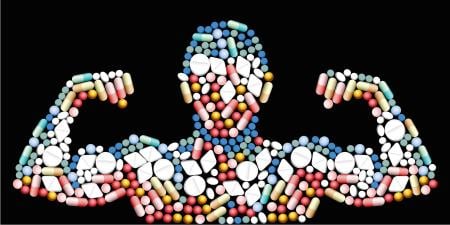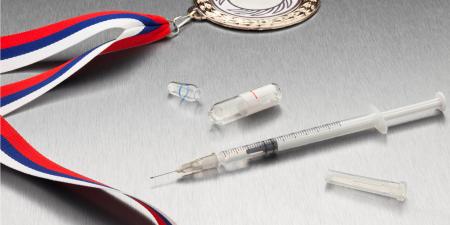Case
Dr. Jarvis, a family physician, enters the exam room to see his next patient, Jim, a star basketball player for the Springfield Tigers, the local high school team. Jim is here today for his routine preparticipation physical examination. He reports that the team has great potential and is hoping to win the state championship. Jim inquires somewhat tentatively about how he could get stronger. Thus far, he has only been using creatine and protein powder and is not satisfied with his strength gains.
In the course of the exam, Jim asks about steroid drugs and mentions that some friends told him that new-generation steroid drugs are not banned from sports. They saw some of these drugs on an Internet site that said their products worked like the real thing but were technically legal. "They must cost a lot of money," observes Dr. Jarvis, trying to remain nonjudgmental for the moment and aware that these drugs sell for several hundred dollars or more. Jim says the pros do it and everyone knows some of the best athletes are "juiced." He says he wants that edge but asks what Dr. Jarvis thinks.
Dr. Jarvis says steroids are questionable as an "edge," but they're a danger sometimes. Too many kids are using them to build muscle too fast and actually get injured as a result. Dr. Jarvis says, "depending on what this drug was, Jim, I might have to report it to someone, the school, your folks, even the police. Many of these drugs are restricted by state and federal laws. And your health is at stake." Jim says OK, and asks the doctor not to tell anyone about their conversation. The doctor suggests some other conditioning methods, completes the screening physical and tells Jim to schedule a follow-up appointment closer to the season. Dr. Jarvis is worried about Jim but is unsure of what his obligations are to the athlete—he does not want to condone the use of nutritional supplements but, if Jim is going to take them, Dr. Jarvis does not want him to do so without medical supervision.
Commentary 1
Franciscan scholar William of Occam, who dissected every question as if with a razor, preferred to remove all extraneous facts and hypotheticals when deliberating. This is a valuable technique in discussing this case. There are 4 extraneous factors confounding this scenario.
The first is the team's potential state title. It is not more moral to cheat to win a state championship than it is to cheat to come in third in district; the end never justifies the means. The second is the player's star status. This has long been held to be irrelevant in our system, although it may have some validity in some monarchical or theocratic societies. We do not accept separate sets of rules willingly.
The third factor is the status of the drugs as "technically legal," and the statement that "some of best athletes are 'juiced.'" The tradition in medicine has always been to value patient safety over all other factors, and this has been reiterated by the Council on Ethical and Judicial Affairs of the American Medical Association many times.1 Other commentators have tried to liken this anabolic competitive advantage to a slicker swimsuit or a snappier vaulting pole. In medical ethics this has no validity, since death and disability are possible. Indeed, this is one area where the patient's star status makes it more important to remain compliant. If this player cheats and endangers his health but raises his ability, he will tacitly coerce other players to imitate him. He therefore will indirectly endanger other players' health.
The last factor is the physician's desire to buffer the patient's danger by "supervising" his drug abuse. This is the most ominous of the extraneous issues because it plays to an historically vulnerable area for physicians, and it has never, to my knowledge, ameliorated a situation. This is analogous to parents' misguided notion that allowing their teenager to smoke will "keep the lines of communication open" or that parents can somehow benefit their teenagers' health by knowing how much they smoke. Physicians usually have a strong sense of duty and service, and this has occasionally been exploited by a government, team, or other organization. For an excellent example, see The Nazi Doctors by Robert Jay Lifton.2 There is no place for "medical supervision" in the case of dangerous, or even potentially dangerous, drugs.
This case, after "Occam's Razor," distills down to whether or not the physician should actively discourage androgen use in otherwise healthy patients, and indeed he should.1,3 In a practical sense, there are several techniques he can employ with the athlete to maximize compliance.
The physician should acknowledge the athlete's concern about competitiveness and not be patronizing. It will help to sit down, preferably positioning himself a little lower than the athlete to avoid appearing dismissive or superior. If a follow-up interview does not call for an exam, he should make a point to touch the patient, such as a pat on the shoulder. If the patient is an older minor and wishes to talk to the physician without the parents present, he should try to have a neutral chaperone available. He should intervene actively in the athlete's training. Does the athlete want a nutritionist to go over his training diet? Is the weight training program supervised by a certified athletic trainer or a certified strength and conditioning coach? Are there some sport-specific techniques that can be added—such as pliometrics in vertical sports and rotational strengthening in throwing sports—to give the desired "edge"? Only when adequate rapport is developed should the physician resort to more graphic illustrations. High school athletes like Jim respond poorly to risk statements about cancer or stroke, but they will usually respond to body-image risks—testicular atrophy in males or masculinization in females.
No physician can prevent a dedicated cheater from violating rules of law, health, and common sense, but that does not relieve us of the responsibility to try.
References
-
American Medical Association. Policy H470.978. Blood Doping. CEJA Rep B, I-85; Reaffirmed CLRPD Rep. 2, I-95). Available at http://www.ama-assn.org/apps/pf_new/pf_online?f_n=resultLink&doc=policyfiles/HnE/H-470.978.HTM&s_t=blood+doping&catg=AMA/HnE&&nth=1&&st_p=0&nth=1&Accessed June 4, 2004.
-
Lifton RJ. Nazi Doctors. New York: Basic Books; 1986.
-
American Medical Association. Code of Medical Ethics. Opinion 3.06 Sports medicine. Available at: http://www.ama-assn.org/apps/pf_new/pf_online?f_n=browse&doc=policyfiles/HnE/E-3.06.HTM&&s_t=&st_p=&nth=1&prev_pol=policyfiles/HnE/E-2.30.HTM&nxt_pol=policyfiles/HnE/E-3.01.HTM&. Accessed June 4, 2004.



